| Consequently,
the enthalpy of exit air is a summation of the
enthalpy of entering air and the addition of enthalpy
from water to air (this is a value of L/G x Range).
Example 2-1.
Calculate the ratio of water and air rate for
the 20,000 gpm of water flow and 1,600,000 acfm
of air flow at DBT 87.8oF, 80% RH,
and sea level.
(Solution)
Water Flow Rate = GPM x (500 / 60) lb/min = 20,000
x (500 / 60) =166,666.67 lb/min
(The weight of 1 gallon of water at 60oF
equals to 8.345238 pounds and 500 was obtained
from 8.345238 x 60 for simplifying the figure.)
Air Flow Rate = ACFM
/ Specific Volume =1,600,000 / 14.3309 =111,646.76
lb/min
(Specific Volume @ 87.8oF, 80% &
sea level = 14.3309 ft3/lb)
Ratio of Water to Air
= Water Flow Rate / Air Flow Rate =166,666.67
/ 111,646.76 =1.4928
Example 2-2.
Why is L/G in the equation of ha2 =
ha1 + L/G x Range called a slope?
(Solution)
This curve is exactly same as a linear function
of y = a + b x. The ha1 corresponds
to "a" , L/G corresponds to "b",
and the cooling range corresponds to "x".
So, L/G is a slope of linear curve.

Example 2-3.
Calculate the enthalpy and temperature of exit
air for the following cooling tower design conditions.
Given,
- Ambient Wet Bulb
Temperature: 82.4oF
- Relative Humidity:
80%
- Site Altitude: sea
level
- L/G Ratio: 1.4928
- Entering Water Temperature:
107.6oF
- Leaving Water Temperature:
89.6oF
(Solution)
The enthalpy of exit air is calculated from Eq.
2-2 which was derived above. That is, ha2
= ha1 + L/G x Range. The enthalpy of
inlet air (ha1) at 82.4oF
WBT & sea level is 46.3624 Btu/Lb dry air.
The cooling range =
Entering Water Temp. - Leaving Water Temp. = (tw2
- tw1) = 107.6 - 89.6 = 18oF
Therefore, the enthalpy
of exit air (ha2) is obtained as below.
ha2 = ha1
+ L/G x Range = 46.3624 + 1.4928 x (107.6 - 89.6)
= 73.2328 BTU/lb
A temperature corresponding
to this value of air enthalpy can be obtained
from the table published by Cooling Tower Institute
or other psychrometric curve. However, this can
be computed from the computer program. The procedure
of computing a temperature at a given enthalpy
is to find a temperature satisfying the same value
of enthalpy varying a temperature by means of
iteration.

Download
the example file(exe2_3.zip) |